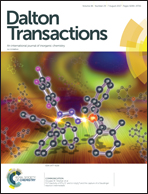FLP reactivity of [Ph3C]+ and (o-tolyl)3P and the capture of a Staudinger reaction intermediate†
Abstract
The frustrated Lewis pair (FLP) derived from the trityl cation and (o-tolyl)3P effects the activation of 1,4-cyclohexadiene and 1-bromo-4-ethynylbenzene and heterolytically cleaves the S–S bond of diphenyl disulfide. The FLP also captures pentafluorophenyl azide as the Staudinger reaction intermediate, a species that reacts with Ph3SiH to give the silyl analog.
![Graphical abstract: FLP reactivity of [Ph3C]+ and (o-tolyl)3P and the capture of a Staudinger reaction intermediate](/en/Image/Get?imageInfo.ImageType=GA&imageInfo.ImageIdentifier.ManuscriptID=C7DT01726J&imageInfo.ImageIdentifier.Year=2017)


 Please wait while we load your content...
Please wait while we load your content...